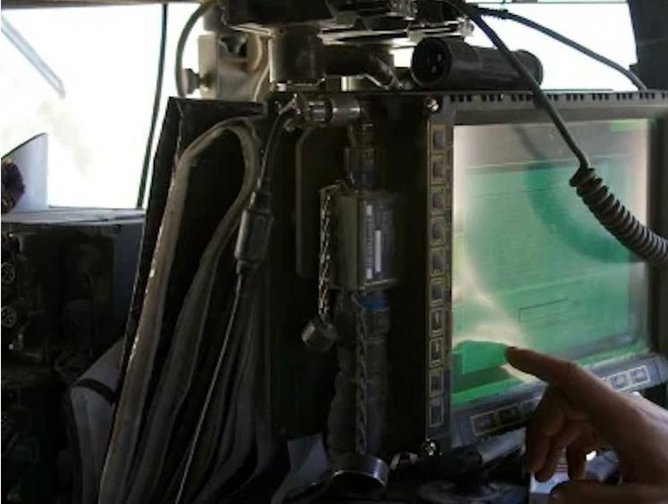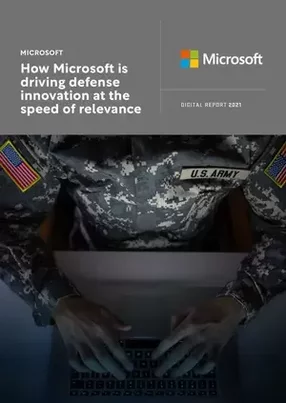How Microsoft is driving defense innovation at the speed of relevance
“Defense and intelligence missions are moving increasingly into the information domain,” says Kate Maxwell, CTO, Defense & Intelligence for Microsoft Worldwide Public Sector. It’s a radical shift from what Maxwell calls “kinetics”, which remain a threat, but even traditional defense benefits from the advances in data science and connectivity.
“Information is helping our defense customers get ahead of their adversaries,” Maxwell explains. “Cloud computing enables secure information sharing across services, domains, and the allied community -- all the way from headquarters to the tactical edge, to that soldier at a forward-deployed location. And once that level of interoperability is achieved, we help our customers figure out how to turn raw data into insights. That's a big leap that is facilitated by capabilities like artificial intelligence, machine learning and high performance computing. Raw data is one thing, but how do we get to insights and infer intent? When our customers can turn data into insights and get inside their adversary’s decision cycle, that's how they find competitive advantage in the digital battlespace.”
Mission speed
Despite Microsoft’s gigantic clout in the cloud computing arena, there’s more to the future of defense than spinning up a Microsoft Azure server or two. “Mission speed,” is one of Maxwell’s mantras, which means 5G and satellite communications are high on her list of priorities, not to mention virtualisation technologies – augmented reality, virtual reality, mixed reality (a significant upgrade to traditional training and mission planning activities that often include “drawing pictures in the sand”). But fostering a culture of innovation is crucial to Maxwell’s own mission.
“As technologists, we often run after the amazing and shiny new technology. But if we don’t get the culture right and really seek to understand how people and technology interact, that new technology is not going to take hold. Period.”
She talks about Will Roper’s ‘digital trinity’ (see box) as a philosophy and is also insistent that “antiquated, quite lengthy” government acquisition is a problem to be fixed. “It’s really hard to drive innovation at the speed of relevance when you have bureaucracy and red tape. But you also have to balance the need for speed with maintaining the integrity of the acquisitions process.
“And then there’s cultural transformation. I mention all these digital models, but people are at the core of any transformation effort. We have to upskill the defense workforce, give them the right digital skills so they’re prepared to build and develop capabilities in new ways. We have to introduce design thinking into workplace processes so we can truly understand the customer and be a mission partner. I feel Microsoft is extremely well positioned to do that. And this is an amazing time to be driving that digital transformation for the defence community.
“Microsoft is an iconic technology enterprise; we’ve been around for a long time, and we’ve been serving defence and intelligence customers for the better part of 40 years. In Worldwide Public Sector, our focus is on delivering world-class capability and digital transformation to the international public sector community. And my team focuses specifically on the allied defense & intelligence community.
“Microsoft has the largest and most mature cloud partner ecosystem in the entire market, which is critical when it comes to driving innovation. Our job is to break down the barriers to entry so independent software vendors can bring their capabilities to bear for the defence and intelligence landscape. It’s a huge part of our value proposition.”
The defence landscape
When Maxwell discusses the defence landscape, she is talking about an array of threats. “This is not meant to be a doom and gloom story,” she says as she paints a picture of growing global disorder where established threats live alongside non-state actors increasingly armed with sophisticated tools. Throw in geopolitical and civil unrest, terrorism, climate change and public health crises, and it looks decidedly doomy and gloomy.
“Technology is advancing at a really incredible pace, and that’s good for defense agencies, but it’s also good for their adversaries, because technology is increasingly capable, available, and in some cases becoming less expensive by the day. Small Unmanned Aircraft Systems (sUAS), or drones, are a great example of this. The US Air Force has maintained air superiority for decades, and all of sudden that air superiority is being threatened by $400 quadcopters that you can buy at any big-box store. The threat is asymmetric, and very real.
“We’re also seeing this evolving defense landscape, where there’s contest in every single domain: land, air, sea, space and cyberspace. The battlefield itself is changing. The landscape is moving increasingly to the digital domain. It’s all about who has information dominance. It’s all about data. It’s about insights. It’s about secure connectivity, especially at the tactical edge.
The DX journey
“At Microsoft, we take a very customer-driven and mission-centric approach to everything we do. This is not a one-size-fits-all digital transformation journey. So, we see three horizons for defence and intelligence. First is the foundational transformation, where we are helping our customers modernise the defence workplace, facilities, and installations. Data is a critical asset, so we help our customers understand where all of their data lives and map out their data estates. Migrating unclassified data and workloads to the cloud is a great first step. Then we help them work out how to harness and fuse that data and put it to work for them.
“The second horizon is about expanding on that transformation and helping our customers become even more data-driven and agile. We help our customers migrate qualified, sensitive data estates to the cloud. We help them take advantage of digital engineering tools and methods, ubiquitous computing, and AI to draw out insights, optimize their operations, and enable a common operational picture across domains, all the way to the tactical edge.
“And the third horizon is about unlocking all of the advanced capabilities that you can bring to bear once you have gone truly digital – enabling our customers to disrupt and deliver innovative mission capabilities at the speed of relevance. This includes a host of advanced capabilities including productivity tools for manned-unmanned teaming, cyber ops capabilities, synthetic environments for training and mission planning, and growing our customers’ network through avenues like space and 5G.
Speed is everything
“Speed,” Maxwell insists, “is everything.” One of her top priorities for the defense & intelligence community is enabling modern methodologies like DevSecOps, and improving the feedback cycle to constantly deliver improvements and high-value mission capabilities. “You don’t win a conflict by being the first to invent a capability,” she explains, “you win by being the first to field it.”
And that’s why she insists government acquisition models need to adapt. “Historically speaking, they have not been set up to accommodate that need for speed. Most government contracting vehicles are set up to support legacy platform procurement – a really lengthy bid, proposal, and development process. That doesn’t work today. And it certainly doesn’t work when you’re talking about building software systems. They demand agility. We have to modernise our acquisition methods to match the mission need, and that will help unlock innovation at the speed of relevance.”
Despite legacy acquisition processes (“antiquated”, “frustrating”), Maxwell notes that they were installed for good reasons, and that change is not just at the service of technology. Those processes were, after all, “put there with good intent.” But the time for change has come.
“The key point is that digital transformation is not just about the technology. It’s also about people, process, and governance. And that, in many ways, is the hardest part.”
When asked why Microsoft is so passionate about the defense & intelligence domain? “These efforts save lives. That’s why I come to work every day. I think it’s incredibly rewarding to see our customers realising the value of their own digital transformation, and hearing success stories from the field. This matters.”
So digital transformation is about cultural transformation? “This is very much a people story. This is about people and their interactions with the system. As Peter Drucker says, ‘Culture eats strategy for breakfast’. One of the things we do at Microsoft, and one of the things that brought me here, is that we put people and mission at the core of everything we do. We frame every digital transformation around the customer need, and their challenges and stakeholders.
“There’s a lot of uncertainty around digital transformation. People might not know what it means for them or for their job. They might be worried. ‘Is my role going to change? Do I have the right skills to do this?’ For every organization that is transforming, your number one objective has to be bringing your people along on that journey, and getting it right so that it works for them. And that is certainly true for defense and intelligence as well. Digital transformation is a people story, and Microsoft is a mission partner.”



- Microsoft in Japan: $2.9bn Investment to Boost AI & CloudCloud & Cybersecurity
- Tech Leaders Launch AI Consortium to Upskill WorkforcesAI & Machine Learning
- Oracle Database@Azure Expansion: Committing to the CloudCloud Computing
- How Microsoft Supports Michigan Medicine’s ModernisationCloud Computing

